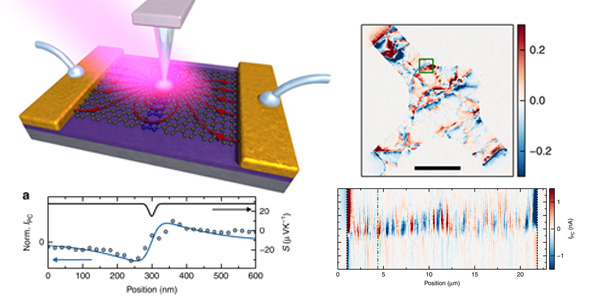Friday, 26 February 2016
Non-Invasive Photocurrent Characterization of Nanoscale Morphologies in CVD Graphene
A recent paper in Nature Communications reports a simple and robust technology using non-invasive opto-electronic nanoscopy to probe locally both the optical and electronic properties of graphene devices. The work results from an international collaboration led by ICFO, with ICN2 participating to the theoretical interpretation of the experiments.

Opto-electronic devices utilizing graphene have already demonstrated unique capabilities and performances beyond the state-of-the-art of existing technologies. However, the requirements in terms of device quality and uniformity are very demanding, and major roadblocks towards high-performance devices stem from complex structural morphologies of large scale graphene (CVD, reduced graphene oxides, etc), which are detrimental to their optimal macroscopic properties.
A recent paper in Nature Communications reports how to apply a non-invasive opto-electronic technique for probing nanoscale optical and electronic features of practical graphene devices. This is achieved by combining scanning near-field infrared nanoscopy with electrical device read-out, enabling infrared photocurrent mapping at length scales of tens of nanometers. This technique is applied to study the impact of edges and grain boundaries on spatial carrier density profiles and local thermoelectric properties in CVD graphene. It is found that such technique can be implemented to scan encapsulated graphene/hexagonal boron-nitride (h-BN) devices. Mid-infrared photocurrent nanoscopy therefore stands as a non-invasive characterization of electrical and optical device properties for a broad range of contacted graphene structures, which should greatly impact on industrial characterization and standardization of graphene technologies. For instance, the characterization of the Seebeck coefficient in presence of grain boundaries in polycrystalline graphene is convincingly described experimentally and theoretically.
The theoretical part of this work was led by the Institut Català de Nanociència i Nanotecnologia (ICN2) Theoretical and Computational Nanoscience Group, headed by ICREA Research Prof Stephan Roche, in collaboration with The Institute of Photonic Sciences (ICFO). As such ICFO and ICN2 are joining forces within the context of Barcelona Institute of Science and Technology (BIST) to push graphene technologies towards faster commercialization.
Article reference:
Achim Woessner, Pablo Alonso-González, Mark B. Lundeberg, Yuanda Gao, Jose E. Barrios-Vargas, Gabriele Navickaite, Qiong Ma, Davide Janner, Kenji Watanabe, Aron W. Cummings, Takashi Taniguchi, Valerio Pruneri, Stephan Roche, Pablo Jarillo-Herrero, James Hone, Rainer Hillenbrand, Frank H.L. Koppens. Near-field photocurrent nanoscopy on bare and encapsulated graphene, Nature Communications 7, 10783 (2016)
http://www.nature.com/ncomms/2016/160226/ncomms10783/full/ncomms10783.html

